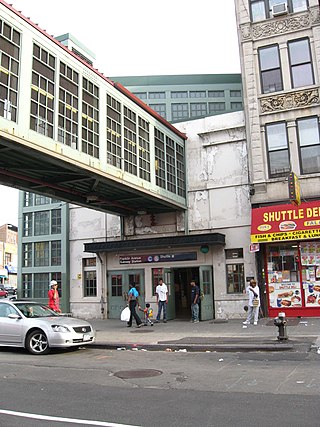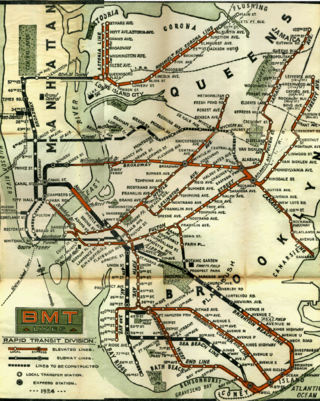The BMT Brighton Line, also known as the Brighton Beach Line, is a rapid transit line in the B Division of the New York City Subway in Brooklyn, New York City, United States. Local service is provided at all times by the Q train, but is joined by the B express train on weekdays. The Q train runs the length of the entire line from Coney Island–Stillwell Avenue to the Manhattan Bridge south tracks. The B begins at Brighton Beach and runs via the bridge's north tracks.

The Brooklyn Rapid Transit Company (BRT) was a public transit holding company formed in 1896 to acquire and consolidate railway lines in Brooklyn and Queens, New York City, United States. It was a prominent corporation and industry leader using the single-letter symbol B on the New York Stock Exchange.

The Franklin Avenue station is a station complex shared by the BMT Franklin Avenue Line and the IND Fulton Street Line of the New York City Subway, located at Franklin Avenue and Fulton Street in Bedford–Stuyvesant, Brooklyn. It is served by the:

The BMT Lexington Avenue Line was the first standard elevated railway in Brooklyn, New York, operated in its later days by the Brooklyn Rapid Transit Company, the Brooklyn–Manhattan Transit Corporation, and then the City of New York.

The Dean Street station was a New York City Subway station on the BMT Franklin Avenue Line. Located on Dean Street west of Franklin Avenue in the Crown Heights neighborhood of Brooklyn, it was serviced by the Franklin Avenue Shuttle. The Dean Street station opened and closed twice in its history, though the line it served continues in operation.

The BMT Franklin Avenue Line is a lower capacity rapid transit line of the New York City Subway in Brooklyn, New York, running between Franklin Avenue and Prospect Park. Service is full-time, and provided by the Franklin Avenue Shuttle. The line serves the neighborhoods of Bedford-Stuyvesant and Crown Heights, and allows for easy connections between the Fulton Street Line and the Brighton Line.
Starting in 1899, the Brooklyn Rapid Transit Company and Brooklyn–Manhattan Transit Corporation operated rapid transit lines in New York City — at first only elevated railways and later also subways.

The Avenue H station is a local station on the BMT Brighton Line of the New York City Subway. It is located at Avenue H between East 15th and East 16th Streets near the border of Midwood and Flatbush, Brooklyn. The station is served by the Q train at all times.

Culver Depot, also called Culver Terminal or Culver Plaza, was a railroad and streetcar terminal in Coney Island, Brooklyn, New York City, United States, located on the northern side of Surf Avenue near West 5th Street. It was just north of the boardwalk, near the former Luna Park amusement complex, and across from the current New York Aquarium. Originally built by the Prospect Park and Coney Island Railroad for the Culver surface line, it later became a major terminal for the Brooklyn Rapid Transit Company (BRT).
The Brooklyn Elevated Railroad was an elevated railroad company in Brooklyn, New York City, United States, operated from 1885 until 1899, when it was merged into the Brooklyn Rapid Transit Company-controlled Brooklyn Union Elevated Railroad.

The Fifth Avenue Line, also called the Fifth Avenue Elevated or Fifth Avenue–Bay Ridge Line, was an elevated rail line in Brooklyn, New York City, United States. It ran above Hudson Avenue, Flatbush Avenue, Fifth Avenue, 38th Street, and Third Avenue from Downtown Brooklyn south to Bay Ridge. The portion on Third Avenue was called the Third Avenue Elevated to distinguish service from the elevated BMT West End Line; it was separate from the elevated IRT Third Avenue Line in Manhattan and the Bronx.

The Fulton Street Line, also called the Fulton Street Elevated or Kings County Line, was an elevated rail line mostly in Brooklyn, New York City, United States. It ran above Fulton Street from Fulton Ferry, Brooklyn, in Downtown Brooklyn east to East New York, and then south on Van Sinderen Avenue (southbound) and Snediker Avenue (northbound), east on Pitkin Avenue, north on Euclid Avenue, and east on Liberty Avenue to Ozone Park, Queens.

From 1898 to 1950, various companies operated local trolley lines over the Brooklyn Bridge, taking passengers from many points in Brooklyn and Queens, New York City, United States to the Park Row terminal in Lower Manhattan. These lines entered the bridge roadway from Fulton Street or Sands Street in Downtown Brooklyn, some of them using elevated trackage at the Sands Street elevated railway station.

The West End Line or New Utrecht Avenue Line was a surface transit line in Brooklyn, New York City, United States, running along New Utrecht Avenue and other streets between Coney Island and Sunset Park. Built by the Brooklyn, Bath and Coney Island Railroad as a steam line, it became a trolley line, along which elevated trains ran until the new elevated BMT West End Line opened. This route is no longer part of any bus line; its southern part was part of a bus route. In 2013, the B64 route to Coney Island was restored.
Court Street – Myrtle Avenue was a station on the demolished BMT Fulton Street Line. The Fulton Street Elevated was built by the Kings County Elevated Railway Company and this station started service on April 24, 1888. The station had 2 tracks and 2 side platforms. Eastbound trains would stop at Court Street, while westbound trains would stop at Myrtle Avenue. It was served by trains of the BMT Fulton Street Line, and until 1920, trains of the BMT Brighton Line. This station was served by steam locomotives between 1888 and 1899. In 1898, the Brooklyn Rapid Transit Company (BRT) absorbed the Kings County Elevated Railway, and it took over the Fulton Street El, and it was electrified on July 3, 1899. It also had a connection to the streetcar line of the same name. It closed on June 1, 1940, when all service from Fulton Ferry and Park Row to Rockaway Avenue was abandoned, as it came under city ownership.

The Fulton Ferry station was a station on the demolished BMT Fulton Street Line in Brooklyn, New York City. As the name implies, it was built to serve the Fulton Ferry between the two ferry slips in Brooklyn and Manhattan. The Fulton Street Elevated was built by the Kings County Elevated Railway Company and this station started service on April 24, 1888. The station had 2 tracks and 2 side platforms. It was served by trains of the BMT Fulton Street Line, and until 1920, trains of the BMT Brighton Line. This station was served by steam locomotives between 1888 and 1899. In 1898, the Brooklyn Rapid Transit Company (BRT) absorbed the Kings County Elevated Railway, and it took over the Fulton Street El, and it was electrified on July 3, 1899. It also had a connection to the Fulton Street trolley. Despite the fact that the ferry ceased operation on January 19, 1924, partially due to the increased use of the Brooklyn Bridge, it closed on June 1, 1940. On June 1 all service from Fulton Ferry and Park Row to Rockaway Avenue was abandoned, as it came under city ownership.
The Elm Place–Duffield Street station was a station on the demolished BMT Fulton Street Line in Brooklyn, New York City. The Fulton Street Elevated was built by the Kings County Elevated Railway Company and this station started service on April 24, 1888. The station had 2 tracks and 2 offset side platforms. It was served by trains of the BMT Fulton Street Line, and until 1920, trains of the BMT Brighton Line. This station was served by steam locomotives between 1888 and 1899. In 1898, the Brooklyn Rapid Transit Company (BRT) absorbed the Kings County Elevated Railway, and it took over the Fulton Street El, and it was electrified on July 3, 1899. It closed on June 1, 1940, when all service from Fulton Ferry and Park Row to Rockaway Avenue was abandoned, as it came under city ownership. Current rapid transit service at these intersections consists of entrances to the Hoyt Street subway station on the IRT Eastern Parkway Line built in 1908.
Cumberland Avenue was a station on the demolished BMT Fulton Street Line. The Fulton Street Elevated was built by the Kings County Elevated Railway Company and this station started service on April 24, 1888. The station had 2 tracks and 2 offset side platforms. It was served by trains of the BMT Fulton Street Line, and until 1920, trains of the BMT Brighton Line. This station was served by steam locomotives between 1888 and 1899. In 1898, the Brooklyn Rapid Transit Company (BRT) absorbed the Kings County Elevated Railway, and it took over the Fulton Street El, and it was electrified on July 3, 1899. It also had a connection to the Greene and Gates Avenues Line trolleys. In 1936, the Independent Subway System built the Fulton Street subway and added a station nearby named Lafayette Avenue despite the fact that it was two blocks southeast of its namesake. The el station became obsolete, and it closed on June 1, 1940, when all service from Fulton Ferry and Park Row to Rockaway Avenue was abandoned, as it came under city ownership.
The Clark-Tillary Streets station was a station on the demolished BMT Fulton Street Line, located on Fulton Street at Clark Street and Tillary Street in Brooklyn, New York City. It was also served by trains traveling via what is now the BMT Brighton Line.













